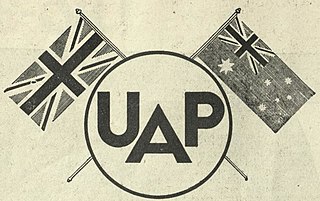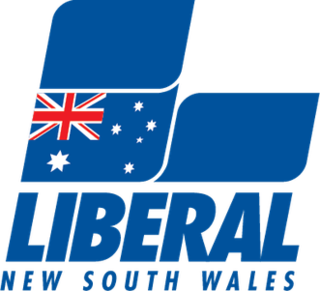
The United Australia Party (UAP) was an Australian political party that was founded in 1931 and dissolved in 1945. The party won four federal elections in that time, usually governing in coalition with the Country Party. It provided two prime ministers: Joseph Lyons (1932–1939) and Robert Menzies (1939–1941).

The Nationalist Party, also known as the National Party was an Australian political party. It was formed on 17 February 1917 from a merger between the Commonwealth Liberal Party and the National Labor Party, the latter formed by Prime Minister Billy Hughes and his supporters after the 1916 Labor Party split over World War I conscription. The Nationalist Party was in government until electoral defeat in 1929. From that time it was the main opposition to the Labor Party until it merged with pro-Joseph Lyons Labor defectors to form the United Australia Party (UAP) in 1931. The party is a direct ancestor of the Liberal Party of Australia, the main centre-right party in Australia.

William Morris Hughes was an Australian politician who served as the 7th Prime Minister of Australia, in office from 1915 to 1923. He is best known for leading the country during World War I, but his influence on national politics spanned several decades. Hughes was a member of federal parliament from Federation in 1901 until his death, the only person to have served for more than 50 years. He represented six political parties during his career, leading five, outlasting four, and being expelled from three.

The Liberal–National Coalition, commonly known simply as "the Coalition", is an alliance of centre-right political parties that forms one of the two major groupings in Australian federal politics. The two partners in the Coalition are the Liberal Party of Australia and the National Party of Australia. Its main opponent is the Australian Labor Party (ALP); the two forces are often regarded as operating in a two-party system. The Coalition was last in government from the 2013 federal election, before being unsuccessful at re-election in the 2022 Australian federal election. The group was led by Scott Morrison until the 2022 Australian federal election, where he resigned as leader. His successor is Peter Dutton.

The Liberal Party of Australia , commonly known as the New South Wales Liberals, is the state division of the Liberal Party of Australia in New South Wales. The party currently governs in New South Wales in coalition with the National Party of Australia (NSW). The party is part of the federal Liberal Party which governs nationally in Coalition with the National Party of Australia.

Lang Labor was a faction of the Australian Labor Party (ALP) consisting of the supporters of Jack Lang, who served two terms as Premier of New South Wales and was the party's state leader from 1923 to 1939.

Sir Percy Claude Spender was an Australian politician, diplomat, and judge. He served in the House of Representatives from 1937 to 1951, including as a cabinet minister under Robert Menzies and Arthur Fadden. He was later Ambassador to the United States (1951–1958) and a member of the International Court of Justice (1958–1967), including as president of the court from 1964 to 1967.

The 1943 Australian federal election was held in Australia on 21 August 1943. All 74 seats in the House of Representatives and 19 of the 36 seats in the Senate were up for election. The incumbent Labor Party, led by Prime Minister John Curtin, defeated the opposition Country–UAP coalition led by Arthur Fadden in a landslide.

The 1940 Australian federal election was held in Australia on 21 September 1940. All 74 seats in the House of Representatives and 19 of the 36 seats in the Senate were up for election. The incumbent Coalition, consisting of the United Australia Party led by Prime Minister Robert Menzies and the Country Party led by Archie Cameron, defeated the opposition Labor Party under John Curtin despite losing the overall popular vote.
This is a list of the members of the Australian House of Representatives in the 16th Australian Parliament, which was elected at the 1940 election on 21 September 1940. The incumbent United Australia Party led by Prime Minister of Australia Robert Menzies with coalition partner the Country Party led by Archie Cameron narrowly defeated the opposition Australian Labor Party led by John Curtin and continued to hold power with the support of two independents. In October 1941 the two independents switched their support to Curtin, bringing him to power.
This is a list of members of the Australian Senate from 1944 to 1947. Half of its members were elected at the 21 September 1940 election and had terms starting on 1 July 1941 and finishing on 30 June 1947; the other half were elected at the 21 August 1943 election and had terms starting on 1 July 1944 and finishing on 30 June 1950. The process for filling casual vacancies was complex. While senators were elected for a six-year term, people appointed to a casual vacancy only held office until the earlier of the next election for the House of Representatives or the Senate.
This article provides information on candidates who stood for the 1946 Australian federal election. The election was held on 28 September 1946.
Members of the New South Wales Legislative Assembly who served in the 35th parliament held their seats from 1947 to 1950. They were elected at the 1947 state election, and at by-elections. The Speaker was Bill Lamb.</ref>
Members of the New South Wales Legislative Assembly who served in the 33rd parliament held their seats from 1941 to 1944. They were elected at the 1941 state election, and at by-elections. During this term, the opposition United Australia Party merged with the new Commonwealth Party to form the Democratic Party in late 1943. The merger was only at a state level, however; the federal United Australia Party, however, remained intact during this period. The Speaker was Daniel Clyne.</ref>

The 1941 New South Wales state election was held on 10 May 1941. This election was for all of the 90 seats in the 33rd New South Wales Legislative Assembly and was conducted in single-member constituencies with compulsory preferential voting.

The 1944 New South Wales state election was held on 27 May 1944. It was conducted in single member constituencies with compulsory preferential voting and was held on boundaries created at a 1940 redistribution. The election was for all of the 90 seats in the Legislative Assembly.

The Menzies government (1939–1941) refers to the federal executive government of Australia led by Prime Minister Robert Menzies. Menzies led the United Australia Party in the Australian Parliament from 1939 to 1941. Menzies served a later and longer term as prime minister as leader of a successor party, the Liberal Party of Australia from 1949 to 1966.

The Fadden government was the federal executive government of Australia led by Prime Minister Arthur Fadden, as leader of the Country Party. He was appointed prime minister on 29 August 1941, during World War II, following the resignation of Robert Menzies of the United Australia Party (UAP). Fadden continued the coalition government between the Country Party and the UAP, but after just over one month in office the government was defeated on a confidence motion. Fadden was succeeded as prime minister on 7 October 1941 by John Curtin of the Australian Labor Party (ALP).

The 1940 Victorian state election was held in the Australian state of Victoria on Saturday 16 March 1940 to elect 44 of the 65 members of the state's Legislative Assembly.

The Liberal Party of Australia , branded as Liberal Victoria, and commonly known as the Victorian Liberals, is the state division of the Liberal Party of Australia in Victoria. It was formed in 1949 as the Liberal and Country Party (LCP), and simplified its name to the Liberal Party in 1965.















